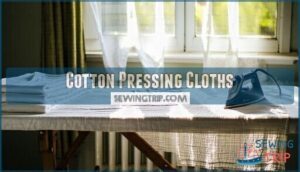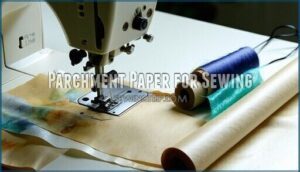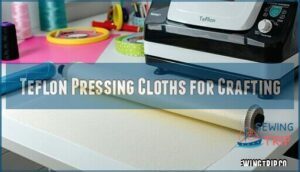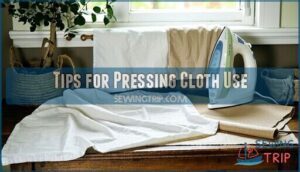This site is supported by our readers. We may earn a commission, at no cost to you, if you purchase through links.
 You don’t need to buy expensive pressing cloths when your linen closet holds perfect alternatives.
You don’t need to buy expensive pressing cloths when your linen closet holds perfect alternatives.
Cotton tea towels, old pillowcases, and clean dish towels create excellent pressing cloth alternatives that protect delicate fabrics from scorching while allowing steam to penetrate effectively.
Even unconventional options like parchment paper, unbleached muslin, or white tissue paper work surprisingly well for quick pressing jobs.
The secret lies in choosing materials that won’t melt under heat, allow moisture to pass through, and leave no residue on your fabrics.
These household items deliver professional-quality results without the specialty store price tag, proving that the best solutions often hide in plain sight, and using them can provide effective and surprisingly good outcomes.
Table Of Contents
Key Takeaways
- You’ll find perfect pressing cloth alternatives in your linen closet – cotton tea towels, old pillowcases, and clean dish towels protect delicate fabrics while allowing steam to penetrate effectively.
- You can use unconventional household items like parchment paper, unbleached muslin, or white tissue paper for quick pressing jobs without spending money on specialty products.
- You’ll get professional-quality results by choosing materials that won’t melt under heat, allow moisture to pass through, and leave no residue on your fabrics.
- You’ll save money and reduce wrinkles more effectively than expensive store-bought pressing cloths while preventing scorch marks on delicate materials like silk or synthetic blends, and achieve delicate fabrics protection.
Choosing Pressing Cloth
You’ll find plenty of effective alternatives when you don’t have a traditional pressing cloth on hand.
Common household items like muslin fabric, old cotton sheets, and clean tea towels work just as well to protect your fabrics from direct heat damage.
Muslin Cloth Alternatives
When you need an ironing cloth substitute, muslin pressing cloth alternatives offer excellent fabric weave properties with superior heat tolerance.
These thin cotton fabric options provide ideal absorbency rates while maintaining cost comparison advantages over specialty products.
Here are five effective muslin alternatives:
- Clean cotton sheet – Lightweight weave provides even heat distribution
- Cheesecloth – Open fabric weave allows steam penetration
- Cotton handkerchief – Smooth surface prevents fabric marking
- Thin tea towel – Good absorbency rates for moisture control
- Cotton voile – Fine weave offers delicate fabric protection
These fabrics can be used as a substitute pressing cloth.
These fabric pressing sheet alternatives maintain availability at local stores, making them practical solutions for immediate pressing needs.
Old Sheets or Pillow Cases
Your clean cotton sheet or pillowcase makes an excellent ironing cloth substitute when you’re in a pinch.
Choose thin cotton fabric with medium thread count for ideal heat transfer without pattern transfer concerns.
Check fabric softness before use – avoid heavily treated materials that might leave residue.
Light-colored sheets work best as pressing cloth alternatives since they won’t bleed onto your garments during the pressing process.
Mesh Ironing Cloths
While mesh ironing cloths offer superior heat distribution and steam penetration compared to traditional alternatives, you’ll find their durability makes them a worthwhile investment for serious fabric care.
These specialized pressing cloth alternatives feature engineered holes that allow steam to pass through while protecting delicate materials from direct iron contact. Knowing the adjustable heat settings is essential for preventing damage.
- Mesh Durability: Withstands repeated washing and high-temperature pressing without deteriorating
- Heat Distribution: Evenly spreads heat across fabric surfaces for consistent results
- Steam Penetration: Allows moisture to reach fabric while maintaining protective barrier
- Fabric Compatibility: Works with synthetics, silks, and other heat-sensitive materials requiring gentle pressing
Benefits of Pressing Cloths
Pressing cloths protect your favorite fabrics from heat damage while delivering professional-quality results every time you iron.
You’ll reduce wrinkles more effectively and prevent those frustrating scorch marks that can ruin delicate materials like silk or synthetic blends.
Preventing Scorching
Using a pressing cloth alternative prevents fabric scorching by creating a protective barrier between your iron and delicate materials.
Heat settings become more forgiving when you place cotton or muslin between the iron’s surface and your fabric. This simple step controls moisture levels and prevents direct contact that causes permanent burn marks.
Proper iron cleanliness paired with pressing cloth alternatives guarantees safe fabric care across various fabric types, eliminating scorching concerns during ironing sessions.
For professional results, consider using specialized pressing tools for curved surfaces.
Reducing Wrinkles
Beyond protecting your fabrics from heat damage, pressing cloths excel at wrinkle removal through controlled steam distribution.
When you place a damp pressing cloth over wrinkled garments, the fabric selection creates an ideal barrier that transforms your iron’s steam power into targeted moisture.
A damp pressing cloth transforms your iron’s steam into targeted moisture magic.
This ironing technique works better than wrinkle sprays alone, making your DIY pressing cloth material essential for professional results.
Improving Ironing Results
Professional pressing mat alternatives deliver superior heat distribution and temperature control compared to traditional methods.
Steam usage becomes more effective when parchment paper pressing or silicone ironing pad creates consistent contact between fabric and iron.
Proper fabric preparation with brown paper pressing prevents shine while Teflon ironing sheet alternatives guarantee smooth gliding motion for superior results.
Types of Pressing Cloths
You’ll find several effective pressing cloth types that match different sewing and ironing needs.
Cotton pressing cloths offer natural breathability, silicone mats provide heat resistance up to 450°F, and parchment paper works well for delicate fabrics that need gentle protection, utilizing silicone mats for enhanced performance is not mentioned but the use of silicone mats is.
Cotton Pressing Cloths
Cotton pressing cloths offer reliable performance when you’re creating your own pressing cloth DIY solution.
These natural fabrics provide excellent heat resistance and controlled absorbency levels, making them ideal for delicate fabrics that need protection during ironing.
- Cotton weaves with higher thread count provide smoother surfaces and better heat distribution
- Natural fibers offer superior absorbency levels compared to synthetic alternatives
- Heat resistance makes cotton suitable for most iron temperature settings
- Best practices include using lightweight cotton like muslin or old cotton sheets
- Homemade pressing cloth options include repurposing cotton t-shirts or pillowcases
Silicone Ironing Mats
For maximum Heat Resistance and Silicone Durability, these mats withstand temperatures up to 450°F while protecting your ironing board cover.
You’ll appreciate their Cleaning Ease—just wipe clean after use. These mats offer a convenient iron rest for safe placement.
Mat Thickness varies, but most provide excellent Ironing Safety on any flat surface, making them the best pressing cloth alternative for DIY enthusiasts.
| Feature | Benefit |
|---|---|
| Heat Resistance | Withstands up to 450°F |
| Durability | Long-lasting silicone construction |
| Portability | Foldable for easy storage |
Parchment Paper for Sewing
Parchment paper serves as an excellent pressing cloth alternative when you’re working on delicate sewing projects. Its heat resistance up to 420°F protects fabric from iron damage while allowing steam penetration.
This cost-effective solution offers multiple sewing applications beyond pressing:
- Prevents fabric shine on synthetic materials during pressing
- Creates barrier between iron and decorative elements like sequins
- Protects delicate lace and embroidered fabrics from direct heat
- Disposable convenience eliminates laundry maintenance requirements
- Readily available in most kitchens for immediate pressing needs
Interestingly, there are many products for this craft. However, parchment limitations include single-use disposal and potential curling at high temperatures, making it less suitable for extended pressing sessions.
Using Pressing Cloth Alternatives
You’ll find that household items work surprisingly well when you don’t have a traditional pressing cloth on hand.
These alternatives protect your fabrics from heat damage while delivering professional-looking results at a fraction of the cost.
Towels as Pressing Cloths
Why settle for basic fabric when towels can double as pressing cloths?
Tea towel pressing works exceptionally well due to superior absorbency levels and heat resistance.
Choose cotton towels with smooth texture effects to avoid lint concerns when using pressing cloth alternatives.
The towel material protects delicate fabrics while your iron glides smoothly, making laundry tasks more efficient and professional-looking with the help of heat resistance.
Teflon Pressing Cloths for Crafting
Beyond the typical pressing cloth options, Teflon pressing cloths offer exceptional Teflon Durability and Heat Resistance for specialized Craft Applications.
These PTFE sheets withstand temperatures up to 600°F, creating a reliable heat resistant barrier that prevents scorching during pressing projects.
These sheets are also useful as non-stick oven liners for baking.
- Teflon Safety guarantees chemical inertness from -200°C to 260°C for consistent performance
- Reusable and tear-resistant design eliminates frequent replacements during household chores
- Non-stick surface prevents fabric adhesion when using pressing cloth for heat transfers
- Easy maintenance with simple Cleaning Teflon methods and helpful cleaning tips
Polyester Blends for Pressing
While Teflon offers heat resistance, polyester blends present different pressing challenges due to their synthetic fabric care requirements.
You’ll need to monitor polyester melting point temperatures carefully, as these blends can damage under high heat.
Practice blend ironing techniques using medium settings to guarantee polyester pressing safety.
The blend heat resistance varies by composition, making temperature control essential for successful household chores and proper garment care during pressing tasks.
Tips for Pressing Cloth Use
You’ll want to match your pressing cloth to your fabric’s heat requirements and texture to avoid damage or shine.
Proper care and storage of your pressing cloths will extend their lifespan and maintain their effectiveness for future projects.
Choosing The Right Fabric
You’ll want to match fabric types to your specific pressing needs, considering heat tolerance as your primary factor.
Natural fibers like cotton and linen handle high temperatures without melting, while synthetic materials can warp under heat.
Texture matters too – smooth, tightly woven fabrics work best for crisp results.
Check color fastness to prevent dye transfer onto your garments during steaming sessions in your laundry room.
Considering fabric weight matters for seasonal appropriateness.
Avoiding Damage to Fabrics
Test your pressing cloth’s heat sensitivity on fabric scraps first to prevent scorching.
Check fabric composition labels before adjusting iron temperature and steam usage accordingly.
Clean pressing cloths regularly to avoid residue buildup that transfers to clothes.
Different materials require specific steaming techniques, so match your approach to fabric needs for wrinkle-free results.
Maintaining Pressing Cloths
Proper care keeps your pressing cloth effective for years.
Clean pressing cloths regularly using gentle detergent to prevent stain buildup that transfers to fabrics.
Store flat or rolled to avoid permanent creases that create uneven pressing surfaces.
When tears appear, simple repair techniques like patching extend lifespan substantially, making your household tips investment worthwhile for wrinkle-free clothes, which is a result of proper care.
Frequently Asked Questions (FAQs)
What fabric can be used as a pressing cloth?
You’ll find cotton muslin works perfectly as a pressing cloth since it’s breathable and protects delicate fabrics from direct heat damage.
Cotton tea towels also serve as excellent alternatives when you’re in a pinch, and they can be considered a breathable option.
Can I use a towel as pressing cloth?
Yes, you can use a cotton towel as a pressing cloth.
Choose a clean, white cotton towel without texture or decorative elements.
It’ll protect your fabric from direct heat and prevent shine, making it an effective household alternative to specialized pressing cloths, and thus a good alternative.
Is a pressing cloth necessary?
A pressing cloth isn’t absolutely necessary, but it’s incredibly helpful for protecting delicate fabrics from direct heat damage.
You can achieve similar results using alternatives like cotton towels or parchment paper when needed.
How can I create a pressing cloth if I don’t sew or own a sewing machine?
You can easily make a no-sew pressing cloth using household items.
Simply repurpose a clean cotton tea towel, muslin fabric, or thin cotton sheet by cutting it to size with scissors.
What fabrics should be avoided when making a homemade pressing cloth?
Avoid synthetic fabrics like polyester, nylon, and acetate since they’ll melt under high heat and damage your iron.
Also skip heavily textured materials, thick towels, and anything with coatings or treatments that could transfer onto your fabric.
How often should I replace my pressing cloth?
Like a Victorian seamstress replacing her thimble, you’ll need fresh pressing cloths regularly.
Replace yours every 3-6 months with heavy use, or when it shows stains, scorching, or fabric deterioration that affects performance.
Can you make homemade pressing cloth alternatives?
You can create effective homemade pressing cloth alternatives using common household items. Cotton tea towels, clean muslin fabric, or even parchment paper work well for protecting delicate fabrics during ironing.
How often should pressing cloths be replaced?
Like fabric under steam’s embrace, pressing cloths endure wear. You’ll need to replace cotton cloths every 3-6 months with regular use, while synthetic alternatives last 6-12 months before losing effectiveness.
What temperature settings work with pressing cloths?
You’ll find most pressing cloths work well with low to medium heat settings, typically between 200-300°F, though some synthetic options handle higher temperatures up to 450°F effectively.
Do pressing cloths work on all irons?
Perfect for most home ironing like a reliable partner, pressing cloths work with virtually all iron types including steam, dry, and professional models.
They’re universally compatible across different brands and heat settings.
They’re also a reliable partner for most ironing tasks.
Conclusion
Like treasure hunters discovering gold in their backyard, savvy crafters have found that the perfect pressing cloth alternative already exists within their homes.
You don’t need specialty items when cotton towels, old pillowcases, or even parchment paper deliver professional results.
These household heroes protect your fabrics from heat damage while maintaining steam penetration.
With proper selection and care, your pressing cloth alternative becomes an indispensable tool that proves effective solutions cost nothing extra.
- https://docs.google.com/forms/d/1GAQr3Kn1cURCVHUA82hAga1Wv8DCH0IuqDLRUrOpN7M/viewform?ts=63f4f653&entry.1515682415=https://www.merriam-webster.com/dictionary%2Fpressing
- https://premium.britannica.com/mw-unabridged/?utm_source=mw&utm_medium=inline-def&utm_campaign=evergreen
- https://idioms.thefreedictionary.com/now+or+never
- https://es.thefreedictionary.com/urgente
- https://learningenglishwithoxford.com/?utm_source=old-site&utm_medium=content-link&utm_campaign=old-content-links













